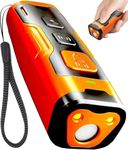We Use CookiesWe use cookies to enhance the security, performance,
functionality and for analytical and promotional activities. By continuing to browse this site you
are agreeing to our privacy policy
Best Dog Barking Deterrents
From leading brands and best sellers available on the web.Buying Guide for the Best Dog Barking Deterrents
Choosing the right dog-barking deterrent can be a game-changer for maintaining peace and quiet in your home. The key to finding the best fit for you and your dog is understanding the different features and how they align with your specific needs. Here are some important specifications to consider when selecting a dog-barking deterrent.Type of DeterrentDog-barking deterrents come in various types, including ultrasonic devices, spray collars, and vibration collars. Ultrasonic devices emit a high-pitched sound that only dogs can hear, spray collars release a burst of citronella or air, and vibration collars provide a gentle vibration. The type of deterrent is important because it determines how the device will interact with your dog. If your dog is sensitive to sounds, an ultrasonic device might be effective. If your dog is more responsive to physical sensations, a spray or vibration collar could be better. Consider your dog's temperament and sensitivity when choosing the type.
RangeThe range of a dog-barking deterrent refers to the distance over which the device can detect barking and activate. This is important because it determines how effectively the device can cover the area where your dog spends most of its time. Ranges can vary from a few feet to several hundred feet. For indoor use, a shorter range may be sufficient, while outdoor use might require a longer range. Assess the areas where your dog barks the most and choose a device with an appropriate range to ensure it can effectively deter barking in those spaces.
Sensitivity LevelsSensitivity levels refer to how easily the device is triggered by barking. This is crucial because you want the device to activate only when necessary and not be set off by other noises. Some devices offer adjustable sensitivity levels, allowing you to fine-tune the device to your dog's barking habits. If your dog has a loud bark, a lower sensitivity setting might be needed, whereas a higher sensitivity setting might be better for a softer bark. Consider your dog's barking volume and choose a device with adjustable sensitivity to avoid false triggers.
Battery LifeBattery life indicates how long the device can operate before needing a recharge or battery replacement. This is important for convenience and ensuring the device is always ready to use. Longer battery life means less frequent charging or changing batteries, which can be particularly useful for busy pet owners. Devices with rechargeable batteries can be more cost-effective in the long run. Consider how often you can realistically recharge or replace batteries and choose a device with a battery life that fits your lifestyle.
DurabilityDurability refers to how well the device can withstand wear and tear, including exposure to the elements if used outdoors. This is important for ensuring the longevity of the device and getting the best value for your money. Look for devices made from high-quality, weather-resistant materials if you plan to use them outside. For indoor use, durability is still important, especially if your dog is active and might knock the device around. Assess where and how you will use the device and choose one that is built to last in those conditions.
Ease of UseEase of use refers to how simple it is to set up and operate the device. This is important because a device that is difficult to use may not be effective if not set up correctly. Look for devices with clear instructions, intuitive controls, and minimal setup requirements. If you are not tech-savvy, a simpler device might be more suitable. Consider your comfort level with technology and choose a device that you can easily manage to ensure it works effectively.



